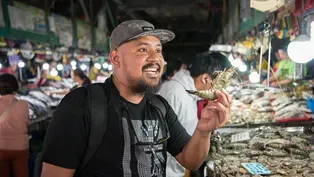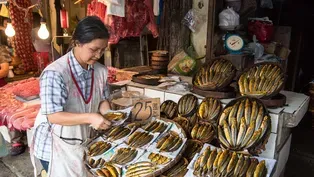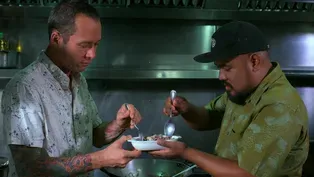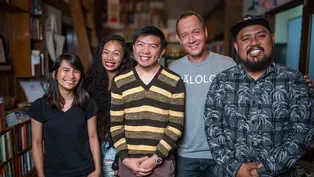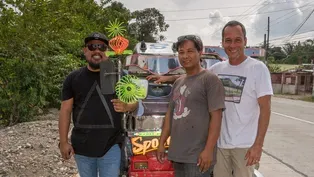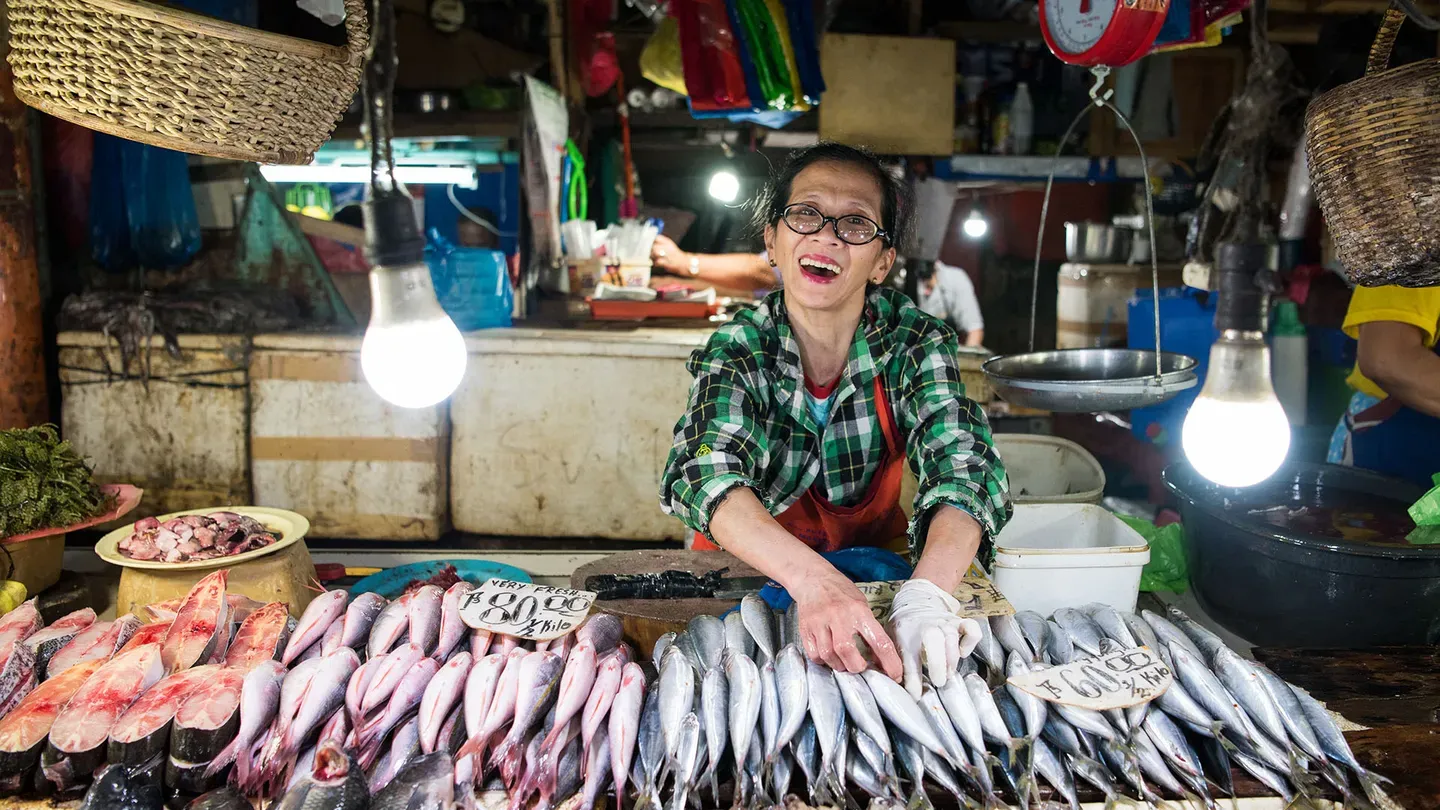

Philippines Adobo
Season 2 Episode 2 | 26m 1sVideo has Closed Captions
Sheldon Simeon finds it easy to shine the light on traditional Filipino dishes.
Bravo Top Chef ‘s Fan Favorite Sheldon Simeon finds it easy to shine the light on traditional Filipino dishes - but it takes a first ever trip to the Philippines to rock his culinary senses. Born and raised in the small town of Hilo, Hawaii, Sheldon credits his dad for his love of the Filipino cuisine. Join Family Ingredients in an episode that shares everything about family, food and fun.
Problems with Closed Captions? Closed Captioning Feedback
Problems with Closed Captions? Closed Captioning Feedback

Philippines Adobo
Season 2 Episode 2 | 26m 1sVideo has Closed Captions
Bravo Top Chef ‘s Fan Favorite Sheldon Simeon finds it easy to shine the light on traditional Filipino dishes - but it takes a first ever trip to the Philippines to rock his culinary senses. Born and raised in the small town of Hilo, Hawaii, Sheldon credits his dad for his love of the Filipino cuisine. Join Family Ingredients in an episode that shares everything about family, food and fun.
Problems with Closed Captions? Closed Captioning Feedback
How to Watch Family Ingredients
Family Ingredients is available to stream on pbs.org and the free PBS App, available on iPhone, Apple TV, Android TV, Android smartphones, Amazon Fire TV, Amazon Fire Tablet, Roku, Samsung Smart TV, and Vizio.

Get Recipes and More
Learn about host and chef Ed Kenney, explore recipes from the show and more.Providing Support for PBS.org
Learn Moreabout PBS online sponsorshipEd Kenney: "Top Chef's" fan favorite Sheldon Simeon finds it easy to shine a light on Filipino cuisine, but it takes his first trip ever to the Philippines to rock his culinary senses.
Hoo-hoo!
[laughing] Look at your face!
Instant water of the eyes right there.
Kenney: Every dish has a story.
Food brings people together and has the power to conjure up cherished memories.
Jack Johnson: ♪ Oh, you're such a pretty thing ♪ ♪ I'll take you, and I'll make you all mine ♪ Kenney: I was born and raised in the Hawaiian Islands, one of the most diverse communities in the world.
Johnson: ♪ We will watch you from the clouds ♪ ♪ We can't stop it, anyhow ♪ ♪ It's not ours ♪ Kenney: In this show, we'll meet a guest from Hawai'i, learn about their favorite dish, trace it back to its origins, and have some fun along the way.
Johnson: ♪ Oh, you're such a pretty thing ♪ ♪ I'll take you, and I'll make you all mine ♪ Kenney: The island of Hawai'i is the youngest island in the Hawaiian archipelago.
It is so ecologically diverse that you can find almost every climate zone on this one island.
The town of Hilo is known for its overcast weather and rain.
It's also known as the birthplace of our guest, Sheldon Simeon.
Sheldon is one of the foremost Filipino chefs in the nation.
All of us eat, sleep, dream food.
And it's just fun to share food with someone else that has that same love and passion for food and feeding people.
What's up?
Hey, Ed.
Ah!
Right on!
Welcome to Hilo, brah.
This is it.
Love this place.
This is it right here.
I love this architecture.
This is home, actually, for me.
Yeah, really!
Kenney: Hilo is this kind of sleepy little town on the east coast of the big island of Hawai'i.
The main drag is right on the water, is this series of cool, hip little restaurants.
Kind of hole-in-the-wall, mom-and-pop places.
There's this phenomenal farmers market where everything is grown within 10 miles of here.
My dad is a retired welder.
45 years he's been welding.
And, growing up, he just builds all kind of stuff.
It's all stainless steel!
Everything's stainless.
He could sell these things.
[laughing] For sure!
So this is a whole pig roaster.
Yup, he has a couple more bigger sizes, but it just runs off of propane and then just do that.
Nuts!
And he builds his own aklo, for the just... What is this, for the wok?
Yeah, for a wok.
He even, like, torches the handle.
No, he was proud about that.
He just told me, "Ho, check 'em out.
Brand-new koa smoke-kine handle.
I mean, that's, like, a recycled, like, rake.
For real!
Yeah, this is a aklo, so get a long handle, and then you get your siliasi or your wok, and then it's just like when you cook for big parties, like that.
This is the house that I grew up in, yeah.
You can hear--listen.
You can hear crickets, roosters, birds.
No more auntie screaming at the kids today, so that's good.
Yeah.
Every single house party or graduation party, my dad would be cooking, so that's why he get all these-- all these different tools.
Would you say your dad is probably your biggest inspiration?
Oh, for sure, by far.
And still yet I-- still, everybody asks me who is the best chef, too?
It's my dad.
Just because I see how much guys that he's fed.
Like, whenever they eat his food, they're always happy, so... Kenney, voice-over: A few years back, Sheldon and I were both mentioned in this group of 10 up-and-coming Hawaiian chefs, and they threw a special dinner for us, and they asked us to bring one of our culinary mentors.
Sheldon and I were the only ones that brought our parents.
Sheldon brought his dad.
I brought my mom.
Everybody else brought a chef mentor that they had worked with in the past.
What would you say is your fondest food memory growing up in this house?
My dad's known for, like, a lot of different dishes.
Like, one of them is, like, his pork and peas or his pancit, but for me, it was always pork adobo.
Pork adobo is the one that, yes, I guess you could eat the most rice.
Ha ha!
Yeah.
Right on.
That's my death-row dish.
If I could have one thing, it would be pork adobo on rice.
Always with a little bit of tomato on the side, too, for us, but... Just to brighten it up.
Kenney: The name adobo is Spanish, but the origins of the dish are entirely Filipino.
When Spanish colonizers arrived in the Philippines, they tasted the dish and called it adobo.
The name stuck, and the original Filipino name disappeared into history.
Adobo is pork that is stewed until it's beautifully tender.
Rich and tangy, the meat is served on a fluffy bed of rice, which absorbs the delicious flavors.
There are many versions of this favorite dish.
The Philippines is divided into many different regions, and each place has its own version, but there are 5 ingredients that are always consistent: vinegar, soy sauce, garlic, bay leaves, and black pepper.
So I heard you're 100% Filipino, as is your dad... Yeah.
And neither of you have ever been to the Philippines.
Never been.
Yeah.
We always talk about it, too.
Because, like, our Filipino cooking is, like, very Hawai'i-based.
Right.
I want to see if it's the same or different or...yeah.
Yeah, yeah.
I don't know.
I don't even know what to fathom about... Yeah, really.
how the dish is gonna taste.
Kenney: I realized we had come into Manila.
There was no place I had ever been that was like it.
Organized chaos, you know?
It was the perfect way to welcome us.
Our host, his name is Danny Urquico.
Danny is the president of CFSPI, which is a nonprofit philanthropic organization.
Stands for Child and Family Services.
He had grown up in Baguio, which is our final destination.
It was about 5 or 6 hours' drive north.
Danny explained to us that Manila is populated by 12 million to 14 million people, and the whole country in comparison is about 100 million.
Almost as quickly as we had arrived in Manila, all of a sudden within an hour, we were hitting rural lands.
One of the sights that I think really paints a picture of the Philippines are what they call tricycles.
And it's really, I think probably an 80cc motorcycle that has a sidecar and a roof attached to it.
They're just so cool.
They remind me of, like, lowriders or something.
Want to squeeze in?
Yeah.
Awesome!
[traffic passing] Kenney: We are moving.
We are moving.
Knock on wood.
[laughs] ♪ I want to ride my tricycle ♪ Take it to max speed, please.
[chuckles] Seriously.
Let's see what this thing can do.
Two big chefs, you know, sitting in here.
So I made him pull over so I could ride sidesaddle.
They're all laughing out here.
[laughter] Kenney: My grandfather came from the Philippines.
My mother really didn't know much about her heritage.
When he moved to America at that time, it was about becoming American and integrating.
She even admits the best adobo she's ever had was made by her dad, and she regrets not being taught how to do it.
We came over this hill, and you just started realizing the size of Baguio.
It's got 300,000 residents, in Baguio, and it's in this hillside community that makes San Francisco look flat.
There's just houses as far as the eye can see.
Initially, Baguio existed because of gold and silver mining.
52% of the people in the country are under 28.
So you have a lot of these young people that are being very creative and entrepreneurial.
Danny put it into perspective when he said, "Out of chaos comes innovation and creativity."
So we traveled all this way to learn about pork adobo.
Danny set us up with the foremost Ilocano chef.
Ilocano is specific to this northern region of the Philippines, and his name is Chef Peter Rodriguez, more fondly known as Chef Nic.
Woke up early.
Had a beautiful Ilocano breakfast-- a little dried crispy fish on rice with a tomato relish.
Chef Nic actually brought garlic longganisa sausage.
A perfect way to start the day.
Simeon, voice-over: What I'm most excited about is tasting the food.
I want to know how different it is.
I cook Filipino food, but it's very Hawai'i-based.
You know, I use Japanese soy sauce; I use American vinegar.
It's whatever ingredients that the Filipinos that migrated to Hawai'i had to use.
Kenney, voice-over: This wonderful woman, Mitos, allowed us to use the kitchen at her restaurant, Hill Station.
Hill Station is one of these buildings that actually was built in 1909.
It first housed the Americans that came to the area.
Then it became the home for the Japanese workers that came.
She let us use her kitchen to learn about pork adobo and a couple other traditional dishes.
Simeon, voice-over: So Chef Nic said he was going to prepare bagnet for me.
And I've never heard of bagnet.
And it looked like the dish lechon kawali would, but this was lechon kawali shot to the roof on another boss level.
Chef Ed, this is pork belly.
My favorite vegetable.
[laughing] Simeon: It's pork belly that's pretty much confit and cooked in its own fat for 3 hours and then cured... Simeon: Was this the same size as that?
Chef Nic: Yes, Chef.
Yeah.
Simeon: So you see how much it shrank down.
Chef Nic: Yeah.
Even the fat layer has-- has kind of... For a 5-pounder, meat, you only get 2 pounds.
Kenney: So that's 60% loss.
Ha ha!
Simeon: and then deep-fried till it gets crispy to get this beautiful popping of the skin.
Simeon: Look at that skin.
Kenney: Oh, that one's beautiful.
Look at that.
So good.
Mmm!
So the next dish that we got to taste from Chef Nic was pinapaitan.
Kenney: OK, I can already tell this is gonna be challenging.
Simeon: And I can already tell this is gonna be delicious.
[laughter] It's all OK, yeah?
You know, it's one of those dishes that... you either like it or you don't.
When I first walked into the kitchen, the first thing I noticed was this bottle of papait, and I was like, Oh, this is the real deal.
We had all the mise en place, all the prepped items out.
Everything was from beef from a cow.
There was liver; there was thin-sliced tenderloin.
There was tripe.
He had actually spinal cord that had been cut into little chunks, and he had this bottle of greenish-brown liquid.
We finally realized that it's bile.
Ever cooked with that, Ed?
Never tasted it.
Never seen it.
It's got a very... Ha ha!
I've never smelt anything like it.
Yeah.
In true Ed fashion, I had to taste this.
And I stuck my pinky in the papait and put it on my tongue, and at that point, I knew I had made the biggest mistake of my life.
[Simeon chuckling] See that?
My hair... Come on, brah.
You gon-- he's gonna taste it raw?
No.
I mean, g-- I got to step up, you know?
Hilo boy not gonna get challenged like that.
Hoo-hoo!
Jeez, right?
Instant water of the eyes right there.
[laughing] Look at your face!
[laughing] Simeon, voice-over: It was... oh, man.
Look, it's so strong in my memory--the taste of it.
It's not even here, and I can still have it on my palate.
Kenney: Take in mind, it was raw.
The finished dish was called pinapaitan.
After having tasted the papait, I got to tell you, I wasn't excited to try the dish.
OK, we're going in.
We're doing whole bites or one thing at a time?
I'm going all in.
I got a little bit of liver, a little bit of tripe.
This is the, um...
Chef Nic: Spinal column.
Spinal column.
[clears throat] I'm amazed by the tripe.
I've always cooked tripe forever, you know?
That was in there with the fire off.
You tasted that by itself, the papait.
Chef Nic: The papait, the papait.
But you don't get it.
There's--it just... Yeah.
It just rounds it out.
You probably don't even taste that.
Yeah.
But I like the little bit of bitter it creates.
The symphony of flavor after cooking is so different, from bitter to sour to salt and sweetness.
I'm blown away by the spinal.
My favorite part of the dish was the spinal cord.
They were soft and tender but creamy.
Chef Nic: ...with vinegar and with chili.
Simeon: And you can eat that raw, too.
Kenney: No, I can't!
Ha ha!
No, you can.
[laughter] Kenney: We then got in the car and went to the market.
They don't call it mercado, which is a Spanish term.
They actually call it market, so here you're already seeing the American influence.
Simeon: Going to the marketplace was a moment that I was waiting for in coming to the Philippines.
And I tell you what, it delivered.
It hits you on all senses.
[indistinct chatter] The strawberries are grown here?
Yes, chef.
Wow!
Simeon: It seems like it's in season right now.
Kenney: Yeah, it's going off!
[indistinct chatter] Kenney: How come they put the gills over here, you think?
Kenney, voice-over: In the fish booth, there was this guy that was filleting fish like I had never seen.
Rather than go in from the bottom, he went in from the back.
He had a fish that was totally filleted out, a pile of bones, a pile of fish guts, and a pile of, like, this one little muscle.
Simeon: 1, 2, 3.
I wish all my cooks could be this efficient!
Kenney, voice-over: We went there specifically with the reason to gather ingredients to cook dinner for a bunch of folks that are getting together tonight.
Simeon: Even a citrus salad, dog.
Kenney, voice-over: We didn't have anything in mind.
This style of cooking I love.
You just go and see what's there and then decide what you're gonna make.
Kenney: Oh, my God.
Look at this.
And beans.
Simeon: Mungo, pigeon peas, black-eyed.
Kenney: Look at this.
Simeon: This with, uh, with pig feet, oh, man!
They have two pressure cookers, two big pressure cookers up there.
Kenney: Oh, yeah, we can do that.
Just make a bean stew with tomatoes.
Yeah, we can probably find some chicharron or some pork fat.
Something.
Right?
Yeah.
Something.
Sauté it off.
Simeon: ♪ I got grains, grains, grains, grains ♪ ♪ Grains I do adore ♪ Man: You smell the difference.
Simeon: That jasmine kind of smell.
Chef Nic: Dinorado, Milagrosa, Sinandomeng.
They're all local.
Kenney, voice-over: Obviously, driving up through the rice patties, they really take their rice seriously.
They had dozens of different sorts of rice.
Some were long-grain and scented rices.
They had short rice.
They had purple, black, brown, red rice.
Simeon: You could cut this up and sell it on the streets right now back home.
[Kenney grunts] Yes, sir.
Here we go.
Kenney: One of the 4 pillars of programs of Child and Family Services and probably one of the most important ones is a program of protection and recovery.
Each year, they take care of victims of sexual assault, domestic violence.
And it was really, really a special opportunity that Sheldon and I got to feed them.
Coming to the Philippines for the first time was a big moment.
Everyone has been so generous.
And as guests, we wanted to give our thanks.
Sheldon and I are both fathers, and we wanted to share a sense of family with these girls.
We thought there would be no better way to do that than to prepare a home-cooked meal for them.
We took all the ingredients that we had purchased at the market and just laid out this huge feast.
And it was really a special opportunity that Sheldon and I got to cook with a few of these girls.
Simeon, voice-over: It was awesome to see what Child/Family Services can do for these girls and, you know, give them an opportunity to make it in this huge city.
Food is such a personal thing.
The number-one thing that I enjoy the most is cooking for someone.
And I guess this was our gift to the girls.
Kenney: We had the privilege of spending some time with some young slam poets at this beatnik bookstore in Baguio called Mt.
Cloud.
I asked the owner, Feliz, Why did she call it Mt.
Cloud?
She let me know it was kind of a play on words.
"Mount" was in its abbreviated form Mt.
So she said it could either be Mount Cloud or "empty" cloud.
[speaking native language] ...Ifugao and Ilocano seesaw inside my mouth, and for the first time, I feel ashamed of knowing more than one language.
I am daughter after daughter of warrior and healer, of farmer and builder, architects of terraces that humbly bow down to my land's acres of pine.
Time after time, my city has proven that it still knows what the word value means.
I'm Jordan.
Nice to meet you.
How you doing?
Oh, hug.
OK. Yeah.
We love to hug!
Hi.
Those performances deserve a hug.
Jordan Hobbling: Thank you.
Thank you.
One thing I noticed is both of you spoke of your heritage, your culture, your language and kind of this tug-of-war that both of you seem to be dealing with-- with modernization, integration but then at the same time preserving Jordan: Sure.
your history and your language.
It has come to our attention that our, um, our culture, specifically our mother tongues, are--we are losing it slowly.
And so I think through these pieces that we do, we are trying to reclaim what was once lost.
So writing about your culture is trying to reconnect with your... Heritage.
Yeah, your heritage, your identity.
Talk about not speaking the language.
Faye Marino: Yeah?
Ha ha!
I'm totally removed, right?
No one speaks it around in my house or anything like that, so... Would you like to have learned?
Oh, definitely!
Like, on this trip, this is, like, going back to my roots and knowing that, that's part of it, too.
So... Simeon: Being born and raised in Hawai'i, being 100% Filipino, now coming back here to the Philippines, oh, just makes me even more proud to be who I am-- a Filipino, you know.
I speak pidgin more than I speak Ilocano.
I barely speak Ilocano.
And my grandparents didn't even speak Ilocano to me, but my way of connecting to my roots has always been food, has always been through cooking adobo.
Simeon: I'm excited to get in the kitchen with Chef Nic.
This long journey--flying to Manila, driving 4 hours up to Baguio City, waiting 34 years of my life-- all coming to this moment and tasting adobo here in the Philippines.
Who taught you how to do this?
My dad.
Your dad?
Yes.
All right!
'Cause I started cooking when I was just small.
OK. Yeah, actually, the kitchen was my playground.
I think all of us.
Yeah, chef.
Kenney: To start off, Chef Nic put a paryiok on the burner cranked on high.
A paryiok is like a thick aluminum wok.
It started with pork belly cut into chunks.
It still had the skin on it and still had spare ribs attached to the bottom side of it in many cases.
Chef Nic: We have to brown this one first.
Kenney: Do you always brown first?
Yeah, chef.
Yeah.
Do you always--do you brown yours at the beginning or the end?
Simeon: No.
We--we just marinate it.
Kenney: This was opposite of what Sheldon does.
He puts it in--just in the liquid in the beginning, and as the liquid reduces, the pork fries in its own fat at the end of the cooking process.
So that's almost complete opposite.
Kenney: What is the word for garlic?
Chef Nic: "Bawang" in Ilocano.
Kenney: Some red onion.
Sauteed it up.
Then some shoyu, some vinegar... Simeon: Ooh, fire!
some water.
Brought that up to a simmer... Simeon: Oh, the color's beautiful already.
Kenney: then added the quintessential adobo flavorings, simply a bay leaf and black peppercorn.
Kenney: How long has this been in here right now?
About 5 minutes?
5 minutes.
I can't wait half an hour.
Sorry.
That's OK, chef.
Ha ha!
Kenney: He let it cook.
During that time, the liquid reduced, and it did continue to fry a little bit in its fat.
Chef Nic: That's the Ilocano version of adobo.
I'm excited to try this.
Here we go.
Ha ha!
Cheers.
Cheers, bro.
Mmm!
Where's the rice?
Yeah, we need rice.
I've never done it with the pig skin on it.
Yeah.
So the skin adds, like, this gelatinous, unctuous... You get it on your lips like that.
That's sticky.
Kenney: This was my ideal type.
It had a little bit of gravy, but it was brown and it was crispy along the edges.
The pork skin itself added, like, this texture and this unctuousness.
Thank you.
Thank you, chef... Simeon: Thank you, chef.
Thank you.
That was beautiful.
Thank you, chef.
I could--I gotta-- I could hug you right now.
[Kenney laughing] All right.
I'm going back in.
Simeon: This trip was, you know, a dream of mine, that to come back and see where my family came from.
The scent and the sights, the sounds--all of that is just...kind of crawling in my skin right now.
It's just, I want-- I want more, you know?
I want to be here more.
I want to share it with the people who are close to me, you know?
Especially, I can only think about my dad.
My dad's my foremost biggest inspiration in all of my cooking.
Lately, I've been trying to come up with an adobo that I can start to call my own and then, you know, start to build memories with my family.
Not only have the influence of my dad's recipe but my formal training background and start to apply those techniques and creating my own.
Kenney: I really think that that is indicative of the way we both look at food.
Looking at those experiences that you had eating together with your family, taking those flavors that you've grown up with that are very familiar to you and then translating them into a restaurant where we can share that with everyone else.
But then we'll travel and we'll taste that same dish done in a different way.
We'll borrow a little bit from them and use a little bit of what we've always done, and the dish evolves on its own.
Reinior: What was your favorite thing in the Philippines?
Oh, I think my favorite moment was when Ed took a shot of apro.
[Reinior laughing] Reinior: One eye-opener.
No can get more fresh than that.
A few extra hairs on his chest, I think.
Sheldon: Yeah.
Chili pepper water shots.
Cheers, guys.
Kenney: Cheers.
Thanks, you guys.
Reinior: Thank you.
Ed, mahalo.
So good!
Unreal.
Kenney: Next on "Family Ingredients"...
So did you grow up around livestock and farming or...?
No.
And, you know, some of the best farmers can be those people who didn't grow up with it.
Kenney: Right.
Kenney: Returning home can reveal memories from your past that you have lost but never truly forgot.
Video has Closed Captions
Preview: S2 Ep2 | 30s | Sheldon Simeon finds it easy to shine the light on traditional Filipino dishes. (30s)
Video has Closed Captions
Clip: S2 Ep2 | 2m 12s | Ed Kenney and Sheldon Simeon shop at the Baguio Market in the Philippines. (2m 12s)
Video has Closed Captions
Clip: S2 Ep2 | 3m 30s | Chefs Ed Kenney and Sheldon Simeon learn how to cook pinapaitan. (3m 30s)
Video has Closed Captions
Clip: S2 Ep2 | 2m 49s | Chefs Ed Kenney and Sheldon Simeon meet young poets who are preserving their culture. (2m 49s)
Video has Closed Captions
Clip: S2 Ep2 | 53s | Chefs Ed Kenney and Sheldon Simeon go on a tricycle ride! (53s)
Providing Support for PBS.org
Learn Moreabout PBS online sponsorshipSupport for PBS provided by:
